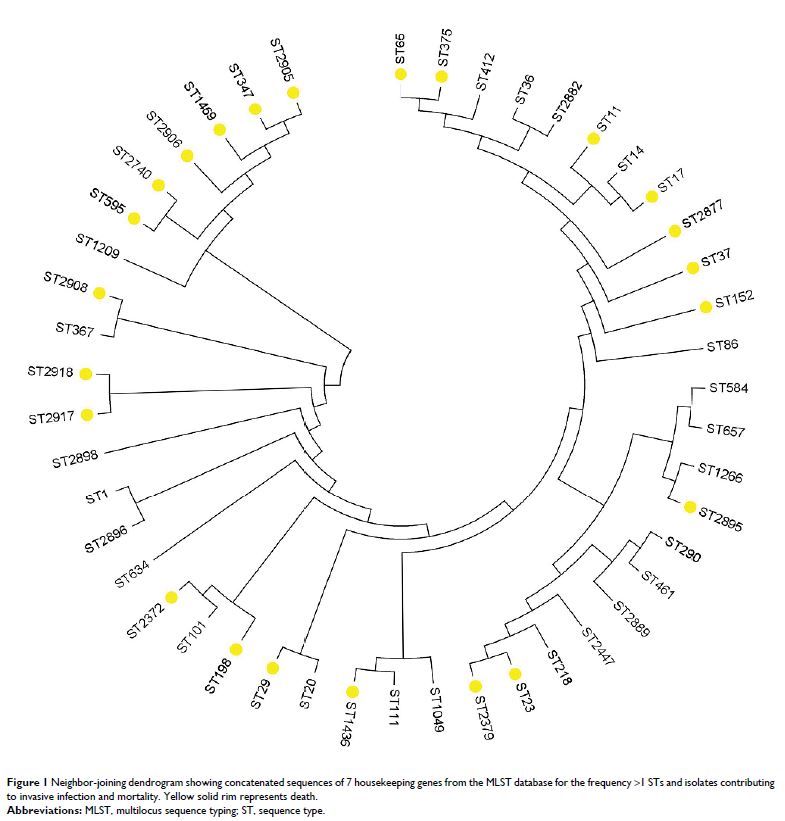108384
论文已发表
注册即可获取德孚的最新动态
IF 收录期刊
- 3.4 Breast Cancer (Dove Med Press)
- 3.2 Clin Epidemiol
- 2.6 Cancer Manag Res
- 2.9 Infect Drug Resist
- 3.7 Clin Interv Aging
- 5.1 Drug Des Dev Ther
- 3.1 Int J Chronic Obstr
- 6.6 Int J Nanomed
- 2.6 Int J Women's Health
- 2.9 Neuropsych Dis Treat
- 2.8 OncoTargets Ther
- 2.0 Patient Prefer Adher
- 2.2 Ther Clin Risk Manag
- 2.5 J Pain Res
- 3.0 Diabet Metab Synd Ob
- 3.2 Psychol Res Behav Ma
- 3.4 Nat Sci Sleep
- 1.8 Pharmgenomics Pers Med
- 2.0 Risk Manag Healthc Policy
- 4.1 J Inflamm Res
- 2.0 Int J Gen Med
- 3.4 J Hepatocell Carcinoma
- 3.0 J Asthma Allergy
- 2.2 Clin Cosmet Investig Dermatol
- 2.4 J Multidiscip Healthc

中国两所教学医院老年患者中有遗传背景者高毒力肺炎克雷伯菌感染的高发病率
Authors Liu C, Shi J, Guo J
Received 29 December 2017
Accepted for publication 15 February 2018
Published 31 July 2018 Volume 2018:11 Pages 1031—1041
DOI https://doi.org/10.2147/IDR.S161075
Checked for plagiarism Yes
Review by Single-blind
Peer reviewers approved by Dr Cristina Weinberg
Peer reviewer comments 2
Editor who approved publication: Dr Joachim Wink
Purpose: Aerobactin is a critical factor for hypervirulent Klebsiella pneumoniae (hvKp)
in genetic backgrounds, but data based on the genotype for the elderly is
limited.
Materials and
methods: A retrospective study was conducted
on elderly patients from June 2008 to July 2017 in 2 teaching hospitals. The
clinical and microbiological data, including antimicrobial susceptibility testing,
string test, extended-spectrum β-lactamase (ESBL) production, virulence gene,
and multilocus sequence typing, of the hvKp group defined as aerobactin
positive were compared with those of classic K.
pneumoniae isolates.
Results: A total of 45.7% of 202 K. pneumoniae isolates
were hvKp.ST23, which were predominant in 2 hospitals, but they were not highly
associated with hvKp in different hospitals. Hypermucoviscosity, K1, K2, magA,
and rmpA/A2 genes were highly
related to hvKp (P =0.000). With
regard to the host, invasive infections (P =0.000), liver
abscess (P =0.000), abdominal infection (P =0.000), pneumonia (P =0.037), and septic shock (P =0.045) were significantly higher
in the elderly with hvKp. In the hvKp group, patients with better nutritional
status were associated with a more severe sequential organ failure assessment
score and a more serious inflammation reaction. Patients with diabetes (odds
ratio [OR]=2.566) are more likely to be infected with hvKp. Previous hvKp is
associated with hypermucoviscosity (OR=15.249) are often paralleled with hvKp.
Importantly, 26% of hvKp isolates produced ESBLs, and most of them showed a
carbapenems-resistant (CR) phenotype. Multivariate analysis implied that
patients with a history of surgery within the last 1 month (OR=15.999) is an
independent risk factor for CR-hvKp infection.
Conclusion: The prevalence of hvKP is high in the elderly. ESBL-hvKp,
especially CR-hvKp, is emerging, which is a sign that clinical awareness and
infection monitoring needs to improve.
Keywords: Klebsiella pneumoniae ,
hypervirulent, aerobactin, risk factor, ESBL-hvKp, CR-hvKp
